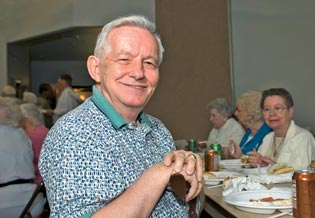 Country living is not always idyllic. Across Canada, the Army is embracing the raw edges of small-town life.
Country living is not always idyllic. Across Canada, the Army is embracing the raw edges of small-town life.
The news in Toronto, as I write, is about the perceived breakdown in community life. Newspapers talk about school violence, youth crime, a sense that, somehow, life is not as safe or even as civilized as it used to be.
The argument runs that it all has something to do with the problems inherent in big-city life. In a major metropolitan area, life can become so detached, so depersonalized-there are not the up-close personal contacts that enrich daily living. The anonymity of urban living deprives us of the support systems that give our lives stability. The stress of both parents working, the long commute to work and the loss of time at home all contribute to an erosion of family life. Families move to big cities and become disconnected from grandparents and other loved ones back home, their mobility further undermining the quality of life.
The drift to the cities has been going on since Canadian census-takers started keeping records. When the first census after Confederation was taken in 1871, only 13 percent of the population lived in urban centres (leaving some 87 percent in rural areas!). By 1931, the year my parents were married, 54 percent lived in urban municipalities, and by 2001, that number rose to 80 percent, making Canada the most urbanized country in the world.
With the shift to the cities has come a sense that we have lost some sort of idyllic existence. There is no doubt that life in smaller communities offers advantages that inhabitants of large cities can only dream about. But life in more rural areas is not altogether problem-free. This reality was part of the agenda in the territory’s first rural ministries conference-a look at the challenges and opportunities that The Salvation Army and the Church face as we serve people who do not live in large urban centres.
These challenges, and the ways in which Army corps are creatively responding to them, have been underscored in my mind as the result of visits my wife and I recently made to various places in Saskatchewan. In one town, with a population of about 2,500, seniors gather in the corps once a week at noon for a “Toonie Lunch.†The meal, prepared and served by local Salvationists and community volunteers, is a bargain for $2, but it’s not the bargain price of the lunch that is the drawing card. The real attraction is social-an opportunity to meet neighbours and share meaningful interaction over a meal. Many of the children have moved away from this ranching community, so fellowship over a meal and devotions addresses the loneliness and isolation that retirement can bring.
In a small community in the other corner of the province, the Army runs a café in the family services/thrift store building. Open five days a week from 9 a.m. until 4 p.m., it is the only place in town for people to meet and enjoy a bowl of soup and a sandwich. Loneliness is the enemy-The Salvation Army is the meeting place.
Drive 60 kilometres south-west and you arrive in another town. In this community of about 6,000, the social blight is the promiscuity of young girls. The dream is a home for them to live in. It’s the same dream that the Army is working on in another small city in the province-a shelter where the love of Christ encompasses counselling, therapy and proper supervision.
As my wife and I headed for the airport, we left with a new sense of the adaptability of The Salvation Army’s ministry and its proximity to the needs of the communities it serves. The shape of ministry and the face of the Army are changing as much in Tisdale, Sask., as they are in Toronto. Corps are embracing the raw edges of rural life. New styles of service delivery, such as circuit ministry, are enabling us to sustain a vibrant presence where the local population base might dictate otherwise.
The Salvation Army, involved in the fabric of community life as the presence of Jesus, offers hope and transformation. The miracle is real.
by Colonel Glen Shepherd, chief secretary
Reprinted from Salvationist, May 2007